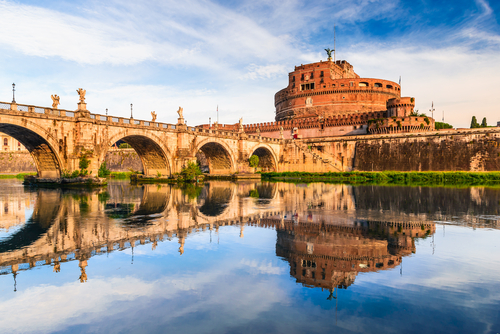Discovering the Ancient Dwellings
There are thousands and thousands of them, dotted throughout the remotest parts of the peninsula and in the hearts of the largest cities. They are Italian castles: noble residences, ancient military fortresses, examples of architecture built just like true works of art. Some are open to visitors, others are abandoned, others are still home to very lucky tenants, and others have decided to open up their Italian castles as hotels, to let others feel a little like kings and queens.
The map of castles in Italy is packed with thousands and thousands of sites that are worth visiting. And we at Dragonfly Tours will take you now on a virtual tour suspended between past and present: together we’ll explore six different castles from north to south.
Castello Sforzesco – Milan
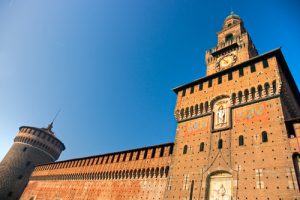 This is one of the most famous Italian city castles. Just outside the center of Milan stands the Sforza Castle, or, Castello Sforzesco, the home of Ludovico Sforza, also known as il Moro, who worked hard to make the castle the artistic element we know today. Today the castle houses art galleries, exhibition halls, libraries, and valuable collections. If you have chosen Milan as the destination of your 20-day luxury tour in Italy from the north to Amalfi, why not take the opportunity to visit this amazing Castle?
This is one of the most famous Italian city castles. Just outside the center of Milan stands the Sforza Castle, or, Castello Sforzesco, the home of Ludovico Sforza, also known as il Moro, who worked hard to make the castle the artistic element we know today. Today the castle houses art galleries, exhibition halls, libraries, and valuable collections. If you have chosen Milan as the destination of your 20-day luxury tour in Italy from the north to Amalfi, why not take the opportunity to visit this amazing Castle?
Castello di Marostica – Marostica (Vicenza, Venice)
This building, among the Italian medieval castles not to be missed, rises like a stronghold nestled on the Pausolino Hill and is interesting because in reality there is not one, but two castles: the Lower Castle and the Upper Castle. The two buildings are contained within a wall almost 2km long. The first, the smaller of the two, was built to keep watch over the land, the second is perched on the highest point of the hill and the view is breath-taking. That same view is no less breath-taking if you are lucky enough to admire it while dining in the restaurant located inside the castle.
Castello Sammezzano – Reggello (Florence, Tuscany)
Sammezzano Castle is an excellent example of Orientalism in Italy, and it is what it is today thanks to the work of Ferdinando Ximenes d’Aragona, who wanted to make it a gem of rare beauty, both for its interiors and its grounds. In fact, the castle’s rooms take us to Arabian lands, to the court of the Chinese emperors, and to the colors of India, all places that Ferdinand never actually visited. He was only familiar with them and able to reproduce them after long and careful study.
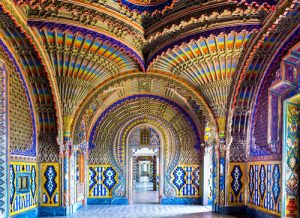 The gardens are full of plants both indigenous and imported from around the world that ornament its 65 hectares. Unfortunately, to date visits are suspended, but there are various committees that are fighting to protect and maintain this beautiful site that, due to problems related to its ownership, now remains closed to visitors.
The gardens are full of plants both indigenous and imported from around the world that ornament its 65 hectares. Unfortunately, to date visits are suspended, but there are various committees that are fighting to protect and maintain this beautiful site that, due to problems related to its ownership, now remains closed to visitors.
Castel Sant’Angelo – Rome
A stop in the capital is always a must, because in Rome, among all the many splendors that the city offers us, Castel Sant’Angelo stands out. Connected to the Vatican by a fortified passageway, it is the protagonist of many stories and legends, and even of the famous novel Angels and Demons by Dan Brown, who uses the castle as a backdrop for his tales, and the videogame Assassin’s Creed also chose the Castle as its setting. In short, if so many people pay homage to it, there must be a reason to see it, right? So, what are you waiting for to book your tour in Rome, between the Sistine Chapel and the Vatican Museums with Dragonfly?
Castel dell’Ovo – Naples
This castle is the oldest building in the entire city of Naples, and there is a curious legend about it that explains how the castle got its name. It is said that Virgil, who, at the time of the birth of the city, was considered to be not only an illustrious sage but also a 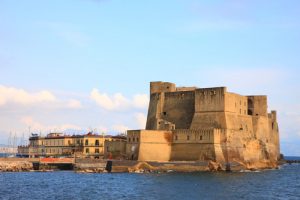 magician, hid an egg (uovo) in a room in the castle. If this egg, protected and hidden, was ever broken, numerous disasters and much ill fortune would be brought down on the city and its people. Today only the stories and the name the Castle of Ovo, (local dialect for egg) remain, while the many rooms of the castle are used for various purposes.
magician, hid an egg (uovo) in a room in the castle. If this egg, protected and hidden, was ever broken, numerous disasters and much ill fortune would be brought down on the city and its people. Today only the stories and the name the Castle of Ovo, (local dialect for egg) remain, while the many rooms of the castle are used for various purposes.
Castel del Monte – Andria (Puglia)
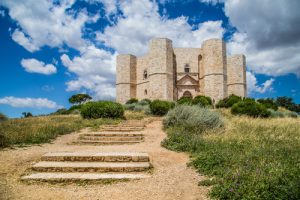 Our virtual tour of the Italian castles ends in a mystical place, Castel del Monte, in Puglia, UNESCO World Heritage Site since 1996, located in the Murgia territory. Why mystical? Because it is full of symbolism that is immediately visible in its octagonal structure: it is said in fact that it is the portal to the heavens because the octagon is a form that connects the square that represents the earth and the circle that instead represents the heavens. It remains a mystical place and a perfect synthesis of rational and geometric architecture, which has endured the passing of the ages and today has been re-evaluated for the splendid site it represents.
Our virtual tour of the Italian castles ends in a mystical place, Castel del Monte, in Puglia, UNESCO World Heritage Site since 1996, located in the Murgia territory. Why mystical? Because it is full of symbolism that is immediately visible in its octagonal structure: it is said in fact that it is the portal to the heavens because the octagon is a form that connects the square that represents the earth and the circle that instead represents the heavens. It remains a mystical place and a perfect synthesis of rational and geometric architecture, which has endured the passing of the ages and today has been re-evaluated for the splendid site it represents.

